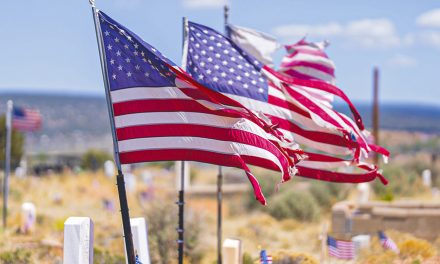
COVID-19 PPP loan applications due March 31
WINDOW ROCK, Ariz.
The American Rescue Plan Act signed into law last week put an additional $7.5 billion toward the popular Paycheck Protection Program, including expanded eligibility for nonprofits and digital news services.
But time is running out to apply. Applications must be submitted by March 31, when the program expires.
The act (H.R. 1319) also added another $15 billion to the COVID-19 Economic Injury Disaster Loan program, with $5 billion targeted for those businesses hardest hit by the pandemic.
Both the PPP and EIDL, administered through the Small Business Administration, provide economic relief to help businesses meet financial obligations that could have been met if the COVID-19 pandemic had not occurred.
Eligible small businesses who qualified prior can receive a second PPP loan, but not another EIDL.
However, if a business already applied for an EIDL loan and was not approved, it has up to six months from the date the loan was declined to reapply.
According to the Small Business Administration website, the Biden-Harris administration made several reforms to the PPP with the goals of ensuring more equitable access to funds, especially small businesses in underserved communities.
Congress also pledged that the latest round of PPP would reach smaller businesses that have not received much-needed relief, including sole proprietors, independent contractors, and self-employed individuals.
“The American Rescue Plan Act enables the SBA to continue to lift up the cornerstones of our communities: the mom-and-pop businesses and nonprofits that provide essential services for our everyday lives,” SBA Senior Advisor Michael Roth said on March 12.
PPP requirements
The PPP specifically provides loans to help businesses keep their workers employed during the COVID-19 crisis and borrowers may be eligible for loan forgiveness.
As of March 7, 7.5 million PPP loans in the amount of $687 billion were approved by lenders in the United States including 30,347 in Arizona, 9,170 in New Mexico, and 17,389 in Utah.
PPP loans can be made for up to $10 million and are issued by SBA-approved lenders. Businesses must apply directly through a qualified lender rather than the SBA.
While there is limited demographic data available on PPP borrowers, the SBA is working to improve that.
Some 27,960 applicants who self-identified as American Indian or Alaska Native have received $1.6 billion in PPP loans, although more than two-thirds of all PPP applicants declined to provide personal information, including ethnicity.
“I highly recommend folks continue to apply,” Karen Allen, senior area manager for Northern Arizona Small Business Administration, told members of the Dineh Chamber of Commerce on Monday.
Depending on one’s financial situation, the PPP is a loan that can turn into a grant if you follow the formulation of having at least 60 percent go to your payroll, said Allen.
The other 40 percent of PPP loans can be used for operational expenses, such as mortgage, rent, utility costs, software and Personal Protective Equipment, but the primary purpose of the PPP is to cover eight weeks of payroll.
In order to be forgivable, the PPP loans have to be spent according to strict guidelines and documentation of that has to be provided. Otherwise, repayment will be owed by the loan recipient.
Paid sick leave and employee benefits that fall under the umbrella of payroll costs can also be covered by the loan.
However, if a business has to reduce staff or compensation, it will also owe on the loan.
The term of a PPP loan is two years, and for any portion of the loan that is not forgiven, the interest rate will be 1%. No collateral or personal guarantee required.
A second PPP loan of no more than $2 million is only available to businesses with 300 or fewer employees in operation as of Feb. 15, 2020, that have used up their initial PPP loan and can prove a 25% or more drop in revenues in 2020 due to COVID-19 impacts.
Like the first PPP loan, a second PPP loan made to eligible borrowers can be forgivable if the forgiveness rules and guidelines are followed.
Economic Injury Disaster Loan
The COVID-19 EIDL of up to $2 million is meant to help businesses established as of Jan. 31, 2020 with 500 or fewer employees to cover six months of operational expenses, but the money does have to be repaid so is not forgivable.
Since last April, the COVID-19 EIDL program has approved 3.7 million applicants for $200 billion in loans.
No demographic data is available at this time.
An EIDL can be used to cover payroll costs, employee benefits, fixed debts like mortgages, rents, or leases, accounts payable, and more.
The term length for EIDL loans is up to 30 years at a rate of 3.75% for businesses and 2.75% for nonprofits.
EIDL funds are issued by the U.S. Treasury and businesses can apply directly on the SBA’s website.
The deadline to apply for a COVID-19 EIDL loan has been extended to Dec. 31, 2021.
Businesses can apply for both the PPE and EIDL loans if they need help paying for payroll and other operating expenses due to pandemic-related hardship and losses.
The primary difference between a PPP loan and an EIDL is that with the PPP you have to spend at least 60 percent of the loan on payroll expenses.
Other small business assistance programs in the American Rescue Plan being administered through the SBA include: $28.6 billion for the Restaurant Revitalization Fund for industry-focused grants, $1.25 billion for the Shuttered Venue Operators Grant program, and $100 million to establish Community Navigator pilot programs where money will be granted to eligible organizations supporting efforts to improve access to COVID–19 pandemic assistance programs.
“Our nation’s more than 30 million small businesses are the economic engine of this country and, in alignment with the Biden-Harris administration’s focus on equitable treatment, the SBA will work tirelessly to ensure eligible borrowers will get access to this critical economic relief,” said Roth.
Information: www.sba.gov/coronavirusrelief
As a public service, the Navajo Times is making all coverage of the coronavirus pandemic fully available on its website. Please support the Times by subscribing.
How to protect yourself and others.
Why masks work. Which masks are best.
Resources for coronavirus assistance








 Highway 264,
Highway 264, I-40, WB @ Winslow
I-40, WB @ Winslow